Debates apart, and beyond controversies in terms of use in high competition, disc brakes dominate the cycling market. If you want to show off a completely updated bicycle, you must mount this type of brakes.
In this guide we tell you everything about its operation and current technologies. We will also share simple (but effective) tricks for care and maintenance.
The disc brake system: parts and operation
Let's start by refreshing some basic concepts. What are the elements that make up the disc brakes?
Handle
Its construction will be different, depending on whether the braking circuit is hydraulic or mechanical. If it is hydraulic, a small tank or pump with brake fluid will have attached to your body inside (mineral or synthetic oil, depending on the brand or model). Through the lever of the handle, pressure is performed on this liquid, moving it to drive the brake tweezers.
If the circuit is mechanical, it will not have a pump or deposit. The same liquid action is carried out, instead, a braided steel cable, which gains or loses tension depending on what we press the handle.
[Captation Id = "Attachment_5973" Align = "Alignnone" Width = "744"]
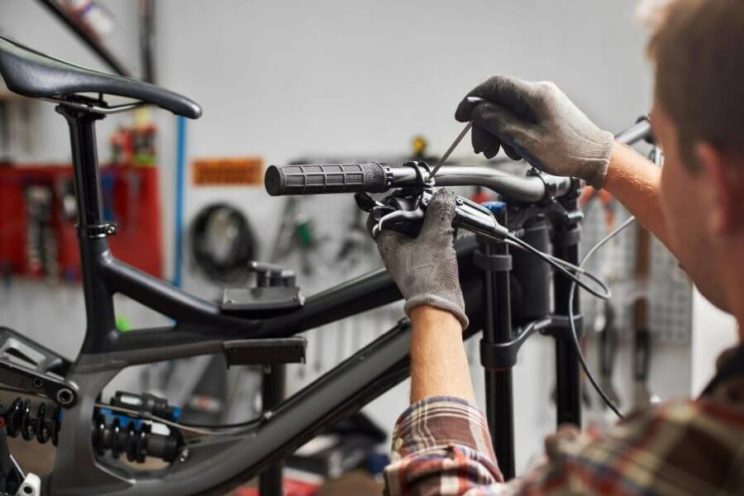
Image: Depositphotos[/caption]
Tweezers
Before the liquid directs that pressure on the clamp and the brake disc, run inside the hose or cable until you reach the piston or piston of the clamp. This, in turn, moves to press the pills, the other internal element of the brake clamp. Currently, two types of tweezers can be distinguished:
-
Of 2 pistons. They are the most common in all cycling modalities. The two pistons are located on each side of the clamp, after the corresponding pill.
-
Of 4 pistons. Above all, in more radical modalities of MTB, such as enduro or descent are used, although it is increasingly common to see it in cross country, rigid bicycles, etc. In this case, the number of pistons is folded: two by each side of the clamp to apply more braking power with the same or similar modulation.
On each side, the first piston located according to the direction of rotation of the album is smaller than the second. With this the
Cable effect or greater braking force that occurs in the area. Thus, the pill is prevented from wear more on one side than on the other and album oscillations are eliminated.
4 piston brake tweezers manage to increase braking power to 20%.
The four-piston tweezers are larger tweezers and about 20-40 gr, heavier than those of two pistons. They are only compatible with specific brake models for 4 pistons and are more expensive: about € 50, on average.
Tablets
When referring to the brake pads, we talk about the metal piece responsible for retaining the rotation of the disc and stop the wheel. A capital piece that has a limited useful life and whose wear should be monitored frequently.
We can distinguish two main types, depending on the compound used from the braking surface: organic (better braking but short duration) and metallic (somewhat more imperfect, but more durable braking).
[Captation Id = "Attachment_7934" Align = "Alignnone" Width = "744"]
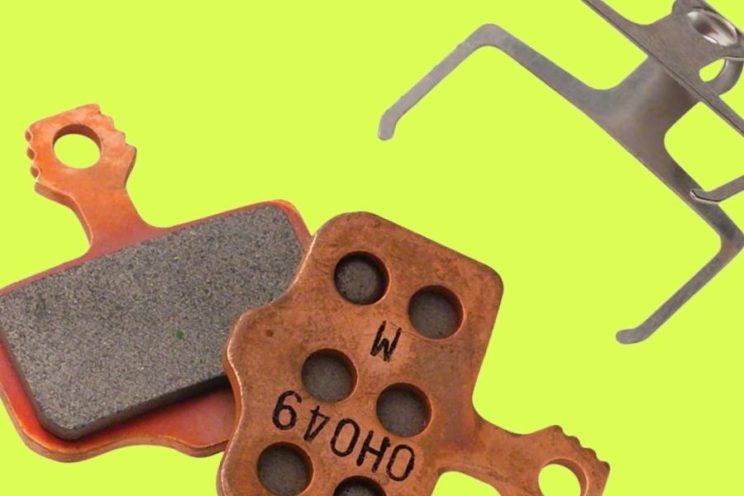
Brake pills, disassembled.[/caption]
Discs
Depending on its size (diameter) and construction (one piece or two pieces), they will enhance some properties or others.
1.- The diameter of the discs
Determine braking capacity. An album of greater diameter will minimize, as a rule, the time since the handle is operated until the wheel stops.
On the other hand, an increase in the diameter of the disc is recommended to assume the greatest power of a specific brake. For example, one of four pistons will require large diameter discs to better assume and manage this power.
Next, let's review the different diameters available in the market.
-
140 mm: The smallest standard today. Majority on road bicycles or cyclocross.
-
160 mm: Intermediate measure, the most used and versatile: MTB Cross country, road or grave.
-
180 mm: more typical of the MTB (as a front brake disc) and in modalities with large braking demands: XC/trail or enduro.
-
203 mm: present mostly in radical modalidaes of the MTB: trail, enduro and descent.
-
220 mm: Specific disc for enduro and descent bicycles, especially in the front wheel.
A larger diameter album tends to minimize the time it elapses from having the brake handle until the wheel stops.
2.- The design and construction of the discs
Depending on its design and structure, the disc can be more or less heavy and better endure the
Heating and fatigue of braking. In this sense, we can distinguish two categories: rigid discs and floating or two -piece discs.
The rigid discs They consist of a piece of stainless steel. They are the most common, which you can find on first -price and mid -range bicycles. Also in high range with special designs to dissipate heat.
Floating or two -piece discs They have an external part or steel braking surface, next to a nucleus of a lighter and heating material (aluminum or carbon). They are more expensive than rigids and are mounted on a half and high range bikes, both on the road and in MTB.
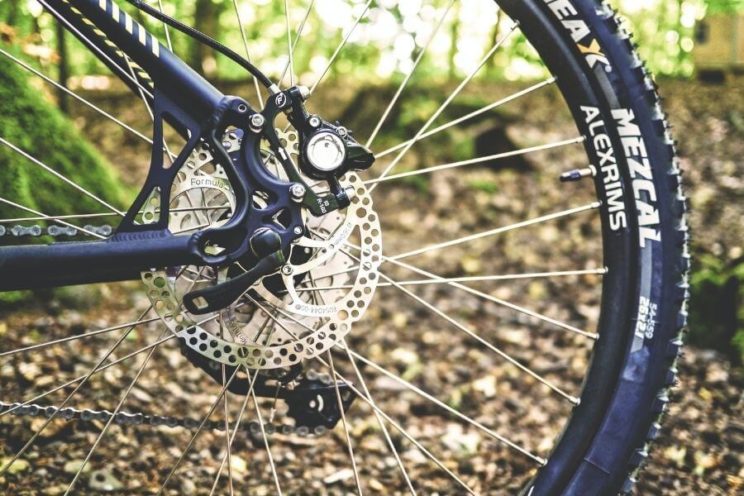
On the other hand, we must take into account the type of wheel bushing anchor, since there is no universal and is important to determine its compatibility with the bike. Two anchor standards can be distinguished: 6 screws (SRAM, mainly) and Center Lock (threaded, patented by Shimano). Most brands have models with versions for one or another system.
Disco brake types
To classify disc brakes, we can attend to two criteria: according to their action and according to the cycling modality.
According to your action
We have already mentioned that there are two universal disc brake systems according to their drive technology: hydraulic and mechanical.
1.- Hydraulic disc brakes
This is the most widespread system. The braking circuit is full of brake fluid (a mineral or synthetic oil) that is pumped from the handle to the clamp. Among its strengths is its more progressive and modulated braking, from less to more, that avoids wheel blockages to favor better control.
[Captation Id = "Attachment_8234" Align = "Alignnone" Width = "744"]
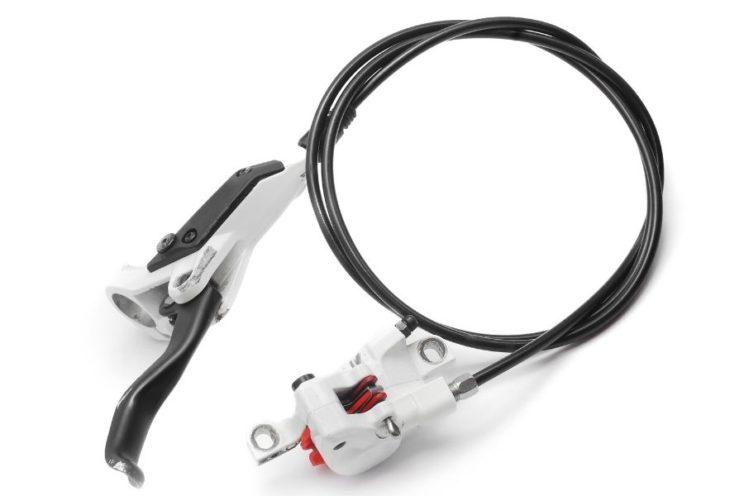
Image: Empire331.[/caption]
2.- Mechanical disc brakes
Mechanical disc brakes use a traditional braking cable. The braking is somewhat more abrupt, less progressive. In addition, they tend to mismatch more and lose touch. However, repairs and adjustments are simpler than in a hydraulic brake. It dispenses with its purged cumbers of the system and fluid replacement.
[IRP Posts = "4210" Name = "Hydraulic or mechanical disc brakes: What are different?"]
According to modality
Another criterion to classify disc brakes is to attend to the cycling modality that we practice.
1.- Mountain Bike
The disc brakes arrived at the MTB more than 20 years ago, in response to increasingly technical tours and the need for a more effective and controlled braking. The disc standard ranges from 160 to 220 mm, and the handle is straight and adjustable in scope (without tool in the upper models). In addition, it is also possible to improve power with four -piston models.
2.- Road
The road disc brakes, with the most recent implementation, have their own particularities, in handles, clamp size and disc diameter. They are smaller than those of MTB (140 and 160 mm) and those of floating type are being imposed on the rigid, with a more widespread and opaque centerpiece, in addition to fins to better dissipate heat (technology
ICE of Shimano).
[Captation Id = "Attachment_2055" Align = "Alignnone" Width = "744"]
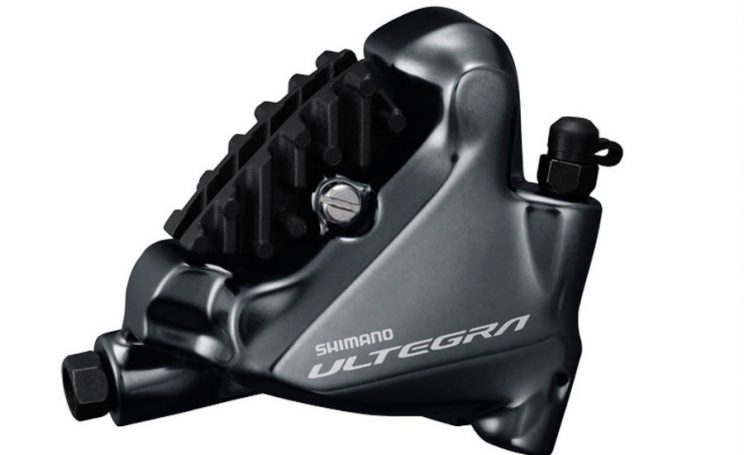
Image: Shimano disc brake clamp.[/caption]
3.- Grave
The disc brakes for Grass have similarities in sizes and technologies with the roads, using the same type of handle for hook handlebars. But the disc diameter is usually greater, opting for 160 or 180 mm. In addition, the brake handles have a different design and ergonomics that provide a better grip of the fingers, sacrificing the weight a bit.
Technologies: New Trends
Do you want to know some of the new technologies that are being imposed on the current disc brakes for cycling?
MANETS: Adjustable in scope and in contact
It is a system present in mountain disc brakes, such as SRAM G2. In addition to the most common adjustment of the position of the handle with respect to the handlebar (through a small wheel) there is another wheel or dial integrated in the body of the handle that regulates the point of contact with the pill. It influences the lever route, giving a firmer or soft touch without moving the position of the pill.
Clashes: four pistons and rigid
The brakes with four pistons have broken the border of the competition and the most extreme MTB modalities. Large brands already offer models for all types of mountain bikes, and in all price ranges.
The emergence of e-bikes, which require more resistant and greater power brakes, has also contributed to this expansion. The tweezers present designs that provide greater integration and rigidity, favoring a braking uniform without vibrations and avoiding the movement or mismatch of the clamp.
Anchorage: Flat Mount
The rear and front brake tweezers
Flat Mount. It allows to do without the adapter of the clamp to screw it to the anchor box
Post Mount, saving some grams, getting a better integration with the bike and greater rigidity in the braking area.
[Captation Id = "Attachment_8231" Align = "Alignnone" Width = "744"]
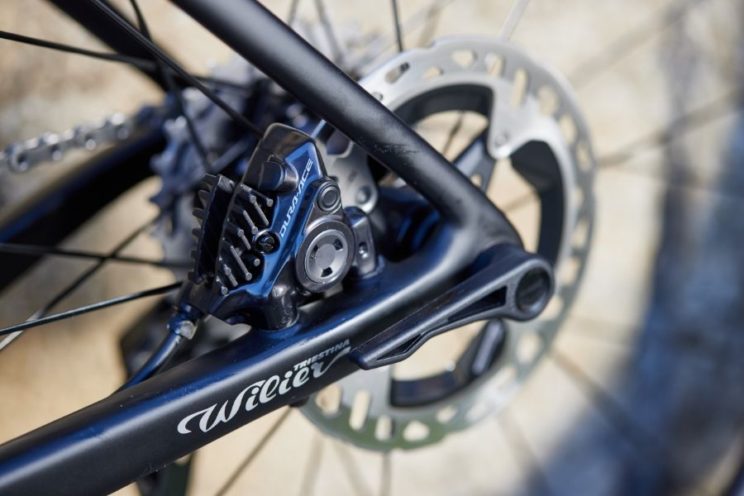
Image: Shimano Dura-Ace Flat Mount System.[/caption]
Cooling and discs cooling
The overheating of disc brakes, for a continuous use of this (in the descents above all) generates fatigue in the system, loss of touch and power. Manufacturers work permanently in technologies that allow the heat of discs and tweezers to better dissipate, the areas where the temperature increases.
In the tweezers, aluminum pistons are being imposed as a solution to overheating.
Shimano has perfected its technology
ICE, called now
ICE FREEZA For its most advanced brakes (Dura-Ace, Ultegra, XT in MTB, etc). It focuses, above all, on discs, adding steel or aluminum fins (depending on the model) in the central part that dissipate heat.
It also adds a thin layer of aluminum in the body and braking track, a material that retains less heat than steel and also a special paint as a coating, capable of reducing 10º C temperature.
For its part, SRAM launched its HS2 albums for Mountain Bike in 2021. They are floating type and have the peculiarity of having nerves with special black paint lining that manage to lower the temperature up to 40º C in the most demanding braking conditions.
[Captation id = "Attachment_8232" Align = "Alignnone" Width = "744"]
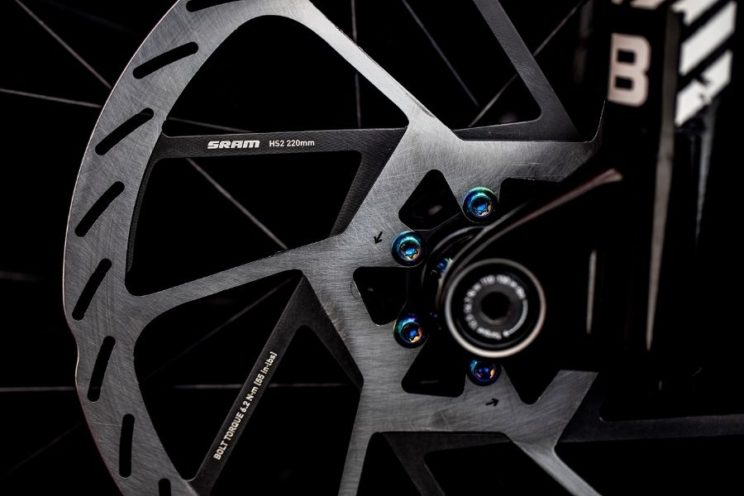
Image: SRAM HS2 discs.[/caption]
Likewise, the increase in disc thickness, from 1.85 to 2 mm, in this case, always translates into heating for the use of more material.
MAINTENANCE: Basic care to avoid breakdowns
The liquid purge operation is one of the most important operations that require good maintenance of disc brakes; Not forgetting the replacement of the pills, of course.
Purged
One should be done a year, whether you use the bike a lot as if not. The brake fluid loses its properties with the use and also without it, so it will be necessary to extract the old liquid pumping it with new liquid from the handle to the output orifice of the clamp.
A priori, it is a simple operation that you could perform at home, but you must have two small hoses, funnel and brake fluid to purge.
[IRP posts = "6451" name = "5 frequent breakdowns of your bike brakes and how to solve them"]
Substitution of pills
The compound of the pills is eliminated in friction with the disc. You will have to verify your status frequently, every two or three months. If its thickness is less than 1 mm, it will be necessary to think about changing it; If you drop to 0.5 mm, you must immediately replace it, since the metallic support of the pill (tougher) would start touching with the disc, damaging its braking track.
You can disassemble the clamp and extract, by means of its metal bridge, the pair of pills to check the wear of the compound. You can perform this operation next to the annual purge, to have a better organization of the maintenance of your brakes. The cost of the pills is not very high, ranging from 10 to 20 euros. You can change them at home without many complications, saving you good money in the workshop's labor.
[IRP posts = "7927" name = "to any pill (brake): types, materials and maintenance"]
Centered tweezers
Strong braking, blows or falls, or simple use, can cause a mismatch in fixing the clamp to the box or fork (in the case of the front brake). This causes a decentralized of the pills with respect to the disc, which generates friction even without actions the brake.
To avoid the annoying noise it generates, and reduce the wear of the compound by these friction, loosen the clamp holding screws. Move it and downs slightly, tightening the handle to realine them with the disc, and squeeze the screws again, alternating this tightening to make it uniform on both sides.
Cleaning: Calls, pills and discs
Books with clean discs, tweezers and handles before starting each route will work more effectively and add years of useful life. A superficial cleaning with soap and water, preventing it from entering the inside of the clamp, is forced after each outlet.
[Captation Id = "Attachment_8235" Align = "Alignnone" Width = "744"]
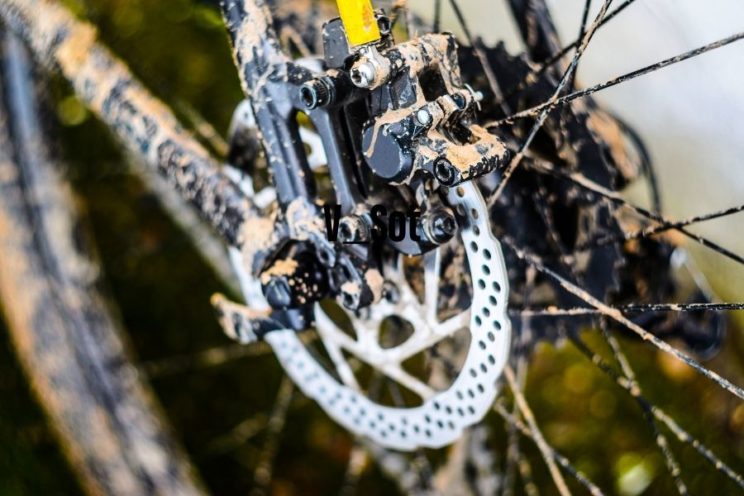
Image: V_Sot.[/caption]
For cleaning the interior of the clamp, which is convenient to perform monthly, you must first remove the pills. Then, clean the interior with neutral soap and water, or a specific disk brake cleaner. Finally, lubricate the surface of the pistons with the same brake fluid of the circuit.
Disc brakes should be checked thoroughly once a year, with fluid replacement and pills.
As for the pills, it reviews that the compound has no rest of dirt, oil, etc. Otherwise, they will be contaminated and it will be necessary to treat them with water and alcohol, and then sand gently to eliminate these remains. If you do not, the effectiveness of the braking will be compromised, as well as the touch when braking.
Cleaning the album braking track is also essential. Make it after each output with a soft cloth (microfiber), a little water and neutral soap. There are also record cleaners in the market, which also have repellent properties of dust or mud.
Do not forget the previous filming
Finally, tips for cyclists little familiar with disc brakes.
To begin with, touch, power and braking modulation is different from that of Zapata brakes. Therefore, previous adaptation and filming is required.
In this sense, when buying a new bike with disc brakes, or after each change of pills, you have to perform a shooting or acclimatization process to the system. Being the surface of the compound of the new pills so firm and polished, they will slip on the disc and not stop it, increasing the risk of accident.
After each change of pills, it is convenient to carry out an adaptation process on the bicycle.
Thus, you have to pedal and touch the brake from less repeatedly, in a plain or street without much traffic, in a controlled way. We recommend doing it until you feel that the touch hardens and the bicycle stops faster. You can also make this shooting, installing the bike on one foot with the wheel suspended in the air and braking repeatedly until it hardens.
With this filming we also got the pills aligned with the disc and its wear is uniform in its entire surface.
 Image: Depositphotos[/caption]
Image: Depositphotos[/caption]
 Brake pills, disassembled.[/caption]
Brake pills, disassembled.[/caption]
 On the other hand, we must take into account the type of wheel bushing anchor, since there is no universal and is important to determine its compatibility with the bike. Two anchor standards can be distinguished: 6 screws (SRAM, mainly) and Center Lock (threaded, patented by Shimano). Most brands have models with versions for one or another system.
On the other hand, we must take into account the type of wheel bushing anchor, since there is no universal and is important to determine its compatibility with the bike. Two anchor standards can be distinguished: 6 screws (SRAM, mainly) and Center Lock (threaded, patented by Shimano). Most brands have models with versions for one or another system.
 Image: Empire331.[/caption]
2.- Mechanical disc brakes
Mechanical disc brakes use a traditional braking cable. The braking is somewhat more abrupt, less progressive. In addition, they tend to mismatch more and lose touch. However, repairs and adjustments are simpler than in a hydraulic brake. It dispenses with its purged cumbers of the system and fluid replacement.
[IRP Posts = "4210" Name = "Hydraulic or mechanical disc brakes: What are different?"]
Image: Empire331.[/caption]
2.- Mechanical disc brakes
Mechanical disc brakes use a traditional braking cable. The braking is somewhat more abrupt, less progressive. In addition, they tend to mismatch more and lose touch. However, repairs and adjustments are simpler than in a hydraulic brake. It dispenses with its purged cumbers of the system and fluid replacement.
[IRP Posts = "4210" Name = "Hydraulic or mechanical disc brakes: What are different?"]
 Image: Shimano disc brake clamp.[/caption]
3.- Grave
The disc brakes for Grass have similarities in sizes and technologies with the roads, using the same type of handle for hook handlebars. But the disc diameter is usually greater, opting for 160 or 180 mm. In addition, the brake handles have a different design and ergonomics that provide a better grip of the fingers, sacrificing the weight a bit.
Image: Shimano disc brake clamp.[/caption]
3.- Grave
The disc brakes for Grass have similarities in sizes and technologies with the roads, using the same type of handle for hook handlebars. But the disc diameter is usually greater, opting for 160 or 180 mm. In addition, the brake handles have a different design and ergonomics that provide a better grip of the fingers, sacrificing the weight a bit.
 Image: Shimano Dura-Ace Flat Mount System.[/caption]
Image: Shimano Dura-Ace Flat Mount System.[/caption]
 Image: SRAM HS2 discs.[/caption]
Likewise, the increase in disc thickness, from 1.85 to 2 mm, in this case, always translates into heating for the use of more material.
Image: SRAM HS2 discs.[/caption]
Likewise, the increase in disc thickness, from 1.85 to 2 mm, in this case, always translates into heating for the use of more material.
 Image: V_Sot.[/caption]
For cleaning the interior of the clamp, which is convenient to perform monthly, you must first remove the pills. Then, clean the interior with neutral soap and water, or a specific disk brake cleaner. Finally, lubricate the surface of the pistons with the same brake fluid of the circuit.
Image: V_Sot.[/caption]
For cleaning the interior of the clamp, which is convenient to perform monthly, you must first remove the pills. Then, clean the interior with neutral soap and water, or a specific disk brake cleaner. Finally, lubricate the surface of the pistons with the same brake fluid of the circuit.












